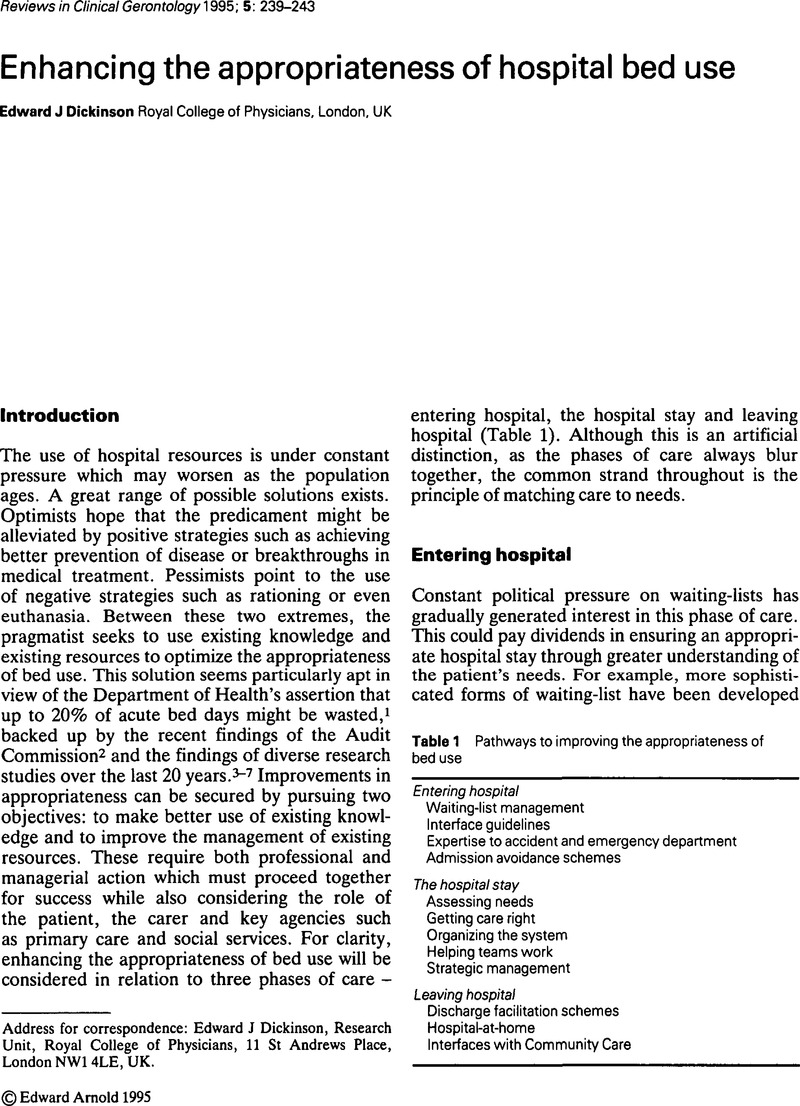No CrossRef data available.
Article contents
Enhancing the appropriateness of hospital bed use
Published online by Cambridge University Press: 17 November 2008
Abstract
An abstract is not available for this content so a preview has been provided. Please use the Get access link above for information on how to access this content.

- Type
- Occasional paper
- Information
- Copyright
- Copyright © Cambridge University Press 1995
References
1Department of Health. Hospital discharge workbook. A manual on hospital discharge practice. London: Department of Health, 1994.Google Scholar
2Audit Commission. Lying in wait: the use of medical beds in acute hospitals. London: HMSO, 1992.Google Scholar
3Rubin, SG, Davis, GH. Bed blocking by elderly patients in general hospital beds. Age Ageing 1975; 4: 142–47.CrossRefGoogle Scholar
6Robinson, M. Relieving pressure on hospital beds. London: Hampstead Health Authority, 1987.Google Scholar
7Anderson, P, Meara, J, Brodhurst, S, Attwood, S, Timbrell, M, Gatherer, A. Use of hospital beds: a cohort study of admissions to a provincial teaching hospital. BMJ 1988; 297: 910–12.Google Scholar
8Lack, A, Fletcher, S, Fletcher, J. A method of assessing priority on surgical waiting lists. 1995 (submitted).Google Scholar
9Royal College of Physicians. Ensuring equity and quality of care for elderly people. The interface between geriatric medicine and general (internal) medicine. London: Royal College of Physicians, 1994.Google Scholar
10Adams, S, Ashkam, J, Glucksman, E, Swift, C, Tinker, A. Falls and elderly people: a study of current professional practice in England and innovations abroad. London: Age Concern Institute of Gerontology, 1991.Google Scholar
11World Health Organisation, King's Fund Centre and Welsh Health Planning Forum. From hospital to home care. In: Costain, D, Warner, M eds. The potential for acute service provision in the home. London: King's Fund Centre, 1992.Google Scholar
12Brook, RH, Kosecoff, JB. Commentary: competition and quality. Health Affairs 1988; 7: 150–61.Google Scholar
13Arden, M, Mayou, R, Feldman, E, Hawton, K. Cognitive impairment in the elderly medically ill: how often is it missed? Int J Geriat Psychiatry 1993; 8: 929–37.Google Scholar
14Dickinson, EJ, Young, A. Framework for the medical assessment of functional performance. Lancet 1990; 335: 778–79.Google Scholar
15Gertman, P, Restuccia, J. The appropriateness evaluation protocol: a technique for assessing unnecessary days of hospital care. Med Care 1981; 19: 855–71.Google Scholar
16Chalmers, I. Improving the quality and dissemination of reviews of clinical research. In: Lock, S ed. The future of medical journals. London: British Medical Journal, 1991.Google Scholar
17Royal College of Physicians and the British Geriatrics Society. High-quality long-term care for elderly people. Guidelines and audit measures. London: Royal College of Physicians, 1992.Google Scholar
18Research Unit of the Royal College of Physicians and the British Geriatrics Society. Standardised assessment scales for elderly people. London: Royal College of Physicians, 1992.Google Scholar
19Research Unit of the Royal College of Physicians and the British Geriatrics Society. Geriatric day hospital. Their role and guidelines for good practice. London: Royal College of Physicians, 1994.Google Scholar
23Whitaker, J, Tallis, R. Misplaced elderly patients in hospital: clarifying responsibilities. Health Trends 1992; 24: 15–17.Google Scholar
24Pearse, M, Woolf, A. Care of elderly patients with a fractured neck of femur. Health Trends 1992; 24: 134–36.Google Scholar
25Sinclair, AJ, Barnett, AH. Special needs of elderly diabetic patients. BMJ 1993; 306: 1142–43.Google Scholar
26Dickson, L, Bennett, G. Chronic wound audit in a department of health care for the elderly. J Tissue Viabil 1993; 3: 3–5.CrossRefGoogle Scholar
27Dudley, NJ, Burns, E. The influence of age on policies for admission and thrombolysis in coronary care units in the United Kingdom. Age Ageing 1992; 37: 95–98.Google Scholar
28Beard, K, Bulpitt, C, Mascie-Taylor, H, O'Malley, K, Sever, P, Webb, S. Management of elderly patients with sustained hypertension. BMJ 1992; 304: 412–16.CrossRefGoogle ScholarPubMed
29Stuck, AE, Siu, AL, Wieland, GD, Adams, J, Rubenstein, LZ. Comprehensive geriatric assessment: a meta-analysis of controlled trials. Lancet 1993; 342 1032–36.Google Scholar
30Langthorne, P, Williams, BO, Gilchrist, W, Howie, K. Do stroke units save lives? Lancet 1993; 342: 395–98.CrossRefGoogle Scholar
32The British Association of Medical Managers, the British Medical Association, the Institute of Health Service Managers and the Royal College of Nursing. Managing clinical services. A consensus statement of principles for effective clinical management. London: Institute of Health Service Managers, 1993.Google Scholar
33Robins, JB, Anthony, GS, MacMillan, R. Profiles of patient care. Hosp Update Plus 1993; 06: 97S–101S.Google Scholar
34lezzoni, LI, Restuccia, JD, Shwartz, M et al. The utility of illness information in assessing the quality of hospital care. The role of the clinical trajectory. Med Care 1992; 30: 428–24.Google Scholar
35McClean, S, Millard, P. Modelling in-patient usage behaviour in a department of geriatric medicine. Methods Inf Med 1993; 32: 79–81.Google Scholar
36Audit working group of the Conference of Medical Royal Colleges. Medical audit activities of the Royal Colleges and their faculties in the UK. London: Department of Health, 1994.Google Scholar
38Bowling, A, Betts, G. Communication on discharge. Nurs Times 1984 (8 08); 80: 31–33.Google Scholar
39Neill, J, Williams, J. Briefing paper. Leaving hospital: elderly people and their discharge to community care. London: National Institute of Social Work Research Unit, 1992.Google Scholar
40Naylor, M, Brooten, D, Jones, R, Lavizzo-Mourey, R, Mezey, M, Pauly, M. Comprehensive discharge planning for the hospitalized elderly: a randomized clinical trial. Ann Intern Med 1994; 120: 999–1006.Google Scholar
41Mamon, J, Steinwachs, DM, Fahey, M, Bone, LR, Oktay, J and Klein, L. Impact of hospital discharge planning on meeting patient needs after returning home. Health Serv Res 1992; 27: 155–75.Google Scholar
42Hollingworth, W, Todd, C, Parker, M, Roberts, JA, Williams, R. Cost analysis of early discharge after hip fracture. BMJ 1993; 306: 903–906.Google Scholar
45Lewis, PA, Dunn, RB, Vetter, NJ. National Health Service and Community Care Act 1990 and discharges from hospital to private residential and nursing homes. BMJ 1994; 309: 28–29.Google Scholar
47ABC (Appropriateness of bed use census) study group. Impact of the introduction of the new Community Care arrangements on the hospital stays of elderly people. Results of the ABC (appropriateness of bed use census) project. 1995 (in preparation).Google Scholar




